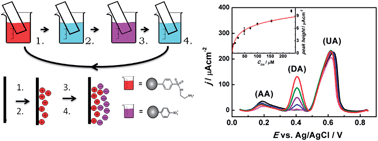Electrochemical determination of selected neurotransmitters at electrodes modified with oppositely charged carbon nanoparticles†
Abstract
The electrocatalytic oxidation of neurotransmitters on the electrodes modified with oppositely charged carbon nanoparticles has been investigated. These nanoparticles were deposited at the electrode from the aqueous suspensions via a layer-by-layer method. The electrocatalytic response was evaluated by cyclic voltammetry, differential pulse voltammetry, and chronoamperometry. The modified electrode exhibited good electrocatalytic properties towards not only dopamine oxidation, but also for epinephrine and serotonin oxidation. This allows us to separate their voltammetric signals from the signals of interfering substances such as ascorbic acid or uric acid. The obtained calibration curves are in the range 0.4–350 μM, 1–49 μM and 0.8–100 μM with detection limits of 0.4 μM, 1.0 μM and 0.8 μM for dopamine, epinephrine and serotonin, respectively. In addition these carbon nanoparticulate electrodes showed excellent sample to sample reproducibility (the relative standard deviations for n = 7 equal 0.7%) and, maintained 94% of electrochemical signal corresponding to dopamine oxidation after 18 month storage.


 Please wait while we load your content...
Please wait while we load your content...